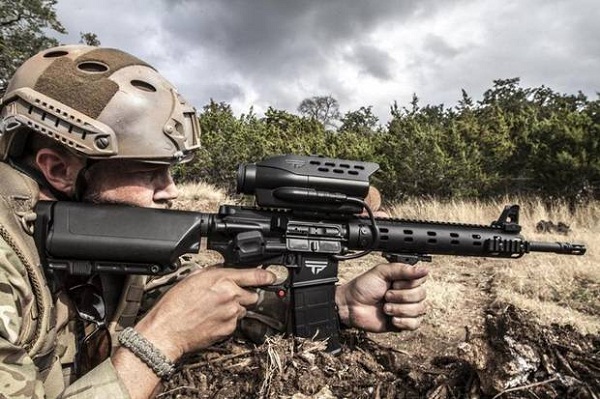James Vincent
The US Army has confirmed that is testing new high-tech rifles that incorporate “computer vision and object tracking technologies” that allow “any soldier [to become] an extraordinary marksman”.
A spokeswoman confirmed reports that specialist equipment-testers had purchased six ‘scope and trigger’ kits built by Texas-based start-up TrackingPoint and would be testing them on XM 2010 sniper rifles.
TrackingPoint’s technology consists of a scope with an on-board computer and a linked trigger. A shooter looking through the scope first ‘tags’ a target before the computer calculates the best place to shoot by measuring 16 different variables, including range, wind, temperature and humidity.
A marker on the scope then indicates the correct “firing solution” and locks the trigger until the shooter has correctly aligned the sights with the target. Tracking Point stress that there is no automatic firing and that “the only way a round can be launched is through human pull force [on the trigger].”
Speaking to the Army Times, Lt Col Shawn Lucas from the army’s Program Executive Office (PEO) said that the technology will help train soldiers for “a relatively small investment” and that it offers “significant increase in probability of hit and overall effectiveness by making an investment in advanced fire control.”
However, the UK defence think tank Rusi has been sceptical, telling the BBC that “this isn’t a revolutionary technology,” but simply the same laser ‘tagging’ systems that are used in “more complex weapons systems.”
“It is not going to create ‘super snipers’ because it still cannot do what is the truly smart aspect of their skills – a full assessment of weather and other conditions that will affect the flight of the bullet and therefore requires considerable calculation to determine adjustments to the aim,” said Peter Quentin of Rusi.
“But while this does not deepen capabilities, it has the potential to broaden them, improving the accuracy of larger numbers of less specialist personnel by enabling the ‘re-tagging’ of a target rather than retaking of a shot.”
TrackingPoint’s systems cost between $10,000 and $27,000 for civilians (£6,030 to £16,280), with the company claiming that the technology can deliver five times the first-shot success rate at distances of up to 1,200 yards (1.1km) when compared with regular rifles.
 A light trail is seen from Lockheed Martin’s prototype ‘self guiding bullet’.
A light trail is seen from Lockheed Martin’s prototype ‘self guiding bullet’.
The start-up is not the only company working on improving the accuracy of guns through technology, and both the Pentagon’s Darpa research unit and American defence contractors Lockheed Martin are working on related systems.
While Darpa’s ‘One Shot XG‘ scope measures crosswinds to improve accuracy, Lockheed Martin are developing self-guiding bullets that uses fins and on-board computers to steer themselves towards laser-marked targets at distance of up to 1.2 miles.
Experts suggest that the increasing popularity of these systems is not only due to advances in technology but also changing tactical trends in warfare. Mr Quentin suggested that in environments such as Afghanistan where army personnel are operating amongst civilians, the need to corerectly identify a target and avoid collateral damage is “paramount”.
“Precision is required when operating amongst populations, such as Afghanistan, where targets must be positively identified and civilian casualties avoided at all costs,” he said.



Just what one needs when going hunting trash on wall street…